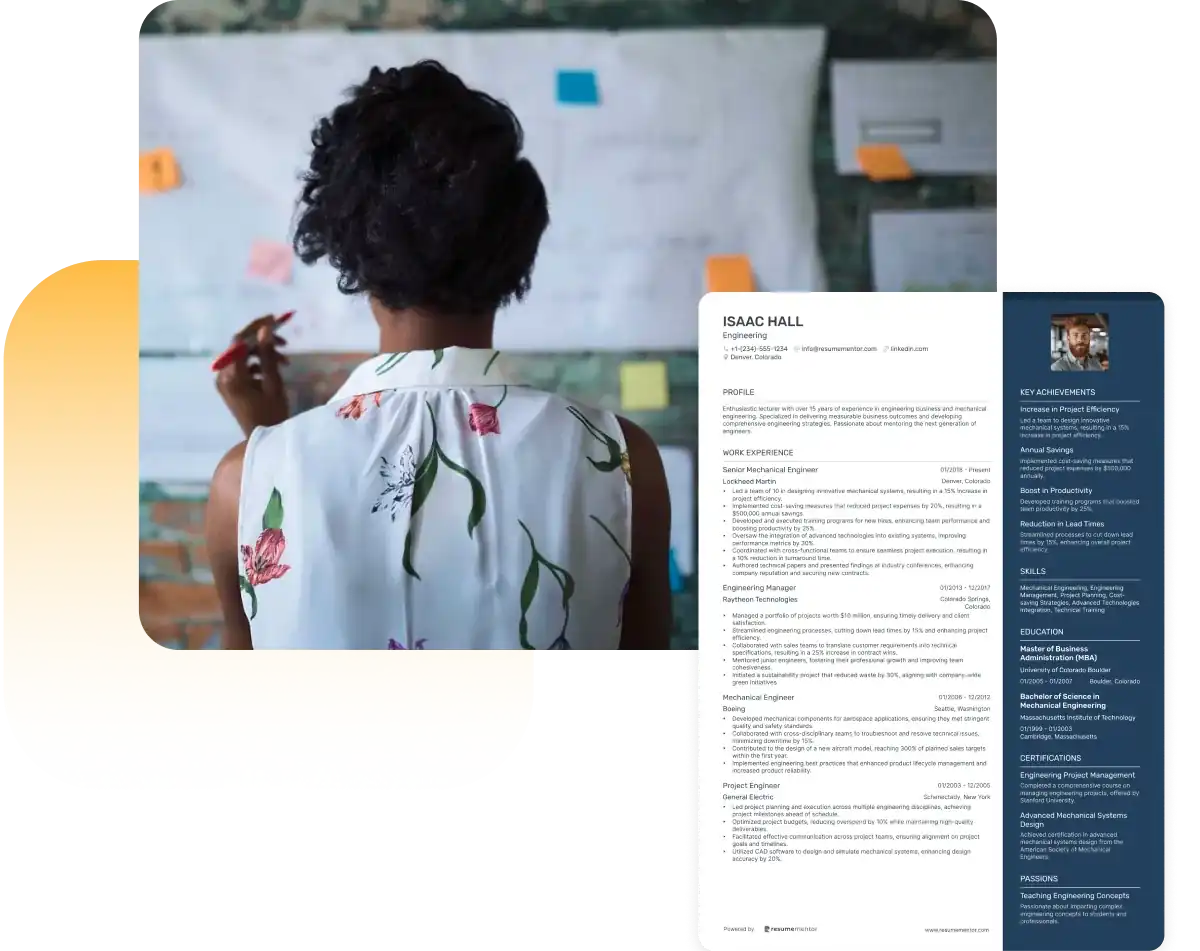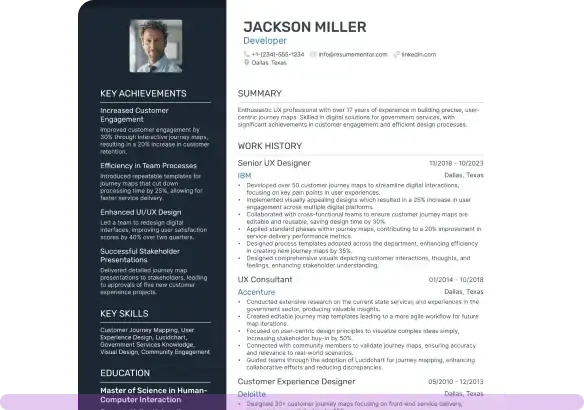How to Put Shadowing on Your Resume (+ Examples)

May 27, 2025
|
12 min read
Elevate your next resume with this additional detail—here’s how.
Do you lack experience? If you’re new to the working world, one way to get ahead of the competition is by shadowing a professional. This move gives you industry experience and a wealth of knowledge right off the bat. However, you need to know how to put shadowing on your resume to show this off.
In the following guide, we’ll share our top tips for getting this right from the start. Plus, we have some adaptable examples you can use when you need some inspiration.
Key takeaways
- Highlighting shadowing experiences on your resume can make you stand out, especially if they’re directly related to your desired field.
- Do this by either creating a dedicated section for shadowing experiences or incorporating them into your work experience or education sections.
- Include all of the most important details, such as the organization or company and your mentor—if you had one.
- Add some action-oriented descriptions to accentuate the skills and insights gained during your shadowing experience.
- Use a chronological order format when displaying shadowing experiences on your resume. You should also regularly update your experience on your resume.
If you’ve previously shadowed a professional, don’t be afraid to brag about it. As we’ll cover in this guide, there are plenty of ways to share your experience on your resume.
Is your resume good enough?
Drop your resume here or choose a file.
PDF & DOCX only. Max 2MB file size.
What is shadowing?
Shadowing is a great way for you to get industry experience ahead of starting work. This is when you follow and observe a working professional in their daily role to gain insights into the job, industry, and workplace dynamics. Typically, shadowing experiences last a matter of months.
In some professions—such as the medical field—shadowing is extremely common. For example, student doctors often shadow mentors to see whether the role suits them. However, this form of work experience is by no means confined to that industry.
Whatever your career aspirations, organizing a shadowing experience is a savvy way to get a taste of the job and see whether it’s right for you.
A survey by the Society for Human Resource Management (SHRM) revealed that nearly 90% of organizations using job shadowing experienced higher employee engagement.
Difference between shadowing and other experiences
Shadowing differs from other experiences on your resume. For example, you may have internships, volunteer work, and formal training that you want to list.
These are all invaluable but you shouldn’t confuse them with formal shadowing. The main difference here is that shadowing involves following a professional in their day-to-day work. Other forms of experience don’t have this feature, which makes them unique.
When a hiring manager sees that you’ve done this, they’ll instantly understand the level of training you’ve had. Observing a professional’s daily tasks means that you have a clear knowledge of what the job entails. That’ll surely be a huge bonus as you can quickly get to grips with the job.
Benefits of including shadowing on a resume
First, let’s talk about why you should have shadowing on your resume. As we’ve already said, this can make your resume stand out from the crowd. But what other advantages does it have?
Advantages to shadowing experience on your resume
- Industry knowledge: Show the hiring manager you have industry knowledge, even if you lack direct experience. Your shadowing will have taught you a wealth of things about how this field operates, which will be invaluable.
- Show dedication: If you’re new to work or a career changer, show the hiring manager you’re serious about this move. Undertaking a shadowing position is the way to go, since it takes time, energy, and dedication to get this right.
- Highlight skills: During your shadowing experience, you’ll have picked up a range of hard skills and soft skills. When listing this experience on your resume, you can illustrate how you’ve honed these competencies over time.
- Bridges career gaps: If there were periods when you weren’t working, the hiring manager may have some questions about how you spent your time. Shadowing experiences can be a smart way to cover these blank periods.
- The perfect fit: One of the major advantages of shadowing a professional is seeing whether the role is right for you and your skill set. Showing a hiring manager that you’ve already completed this stage lets them know you’re the right fit. Put simply, it means that you’ve tried a career and loved it enough to pursue it.
How to format shadowing on a resume
Formatting matters when you’re including shadowing on your resume. The aim of the game is to give the hiring manager all the information they need. You want this to be clear and concise.
Let’s take a look at the information you need to add here:
Company or organization
First up, list the company or organization where you completed this experience. You should put the full company name at the top of each entry.
Location
Next, you don’t have to provide the full address of the business. This is an outdated approach. Instead, simply give the location — e.g. the city and state.
Dates of experience
This next part is important as it tells the hiring manager how recent the experience was and how long it lasted. Include the month and the year of the start and end. For example, you might write something like “Mar 2021 - Aug 2021.”
Vital tasks and achievements
Here’s where the bragging starts. Be clear about what tasks you tried your hand at and any achievements you gained along the way. Wherever possible, add metrics to back up the claims you make. This will allow the hiring manager to quickly and easily see how valuable you could be.
Name and title of professional (optional)
Finally, you must identify who you shadowed. You can detail their name and job title. You may also want to elaborate on this experience when writing your summary or cover letter.
Job shadowing signals to employers that you’re interested in the field and willing to learn — which can make you stand out, especially as an entry-level candidate.
Harvard Career Services
Where to include shadowing on a resume: four options
Next up, let’s talk about where to list shadowing on your resume. You have four distinct options you can choose from. Read the below and then decide which one works best for you.
Work experience section
Adding your shadowing to your work experience section is a logical move. If your shadow experience aligns with the other positions on your resume, this is the way to go. You can slot this in as you would any other job, in reverse chronological order.
However, you should make it obvious that this was a shadowing placement. You don’t want the hiring manager to think it was a full-time position.
Let’s take a look at an example below.
- •Managed a caseload of 50+ patients weekly, achieving a 90% satisfaction rate based on patient surveys.
- •Collaborated with a multidisciplinary team to improve treatment protocols, reducing patient readmission rates by 15%.
- •Supervised and mentored 10+ medical residents and interns annually.
- •Performed 1,000+ diagnostic and therapeutic procedures with a focus on patient safety and outcomes.
- •Contributed to research that led to a publication in a peer-reviewed medical journal.
- •Received Resident of the Year Award in 2014 for outstanding clinical performance and teamwork.
- •Shadowed a senior cardiologist during daily rounds, gaining insights into patient assessment and care planning.
- •Observed 50+ diagnostic procedures, including echocardiograms and stress tests.
- •Developed a foundational understanding of patient communication and bedside manner in a clinical environment.
Education
While shadowing is a type of work experience, it’s also a type of education. So, it can be slid easily into either section. When listing it in your education section, place it in reverse chronological order as well. Below the main information, you can add bullet points that flesh out what you’ve learned.
Check out our example for inspiration.
- •Graduated with Honors in Research for contributions to cardiology studies.
- •Graduated Summa Cum Laude with a focus on molecular biology and genetics.
- •Shadowed physicians in the cardiology and internal medicine departments.
- •Gained hands-on insights into diagnostic techniques and patient care practices.
- •Observed over 50 patient consultations and participated in case discussions.
Dedicated section
Do you have more than one shadowing experience? If so, you can create a dedicated section on your resume. Use the same structure you’d use for a work experience section. However, you should make it 100% clear that this is a shadowing section by adding a label.
Take a look at how that would appear below.
- •Followed a senior cardiologist during rounds, witnessing 50+ patient consultations and procedures.
- •Gained an understanding of echocardiography and stress testing through direct observation of diagnostic sessions.
- •Participated in case discussions, contributing observations and questions to improve understanding.
- •Observed 20+ surgeries, including appendectomies and corrective procedures for congenital conditions.
- •Shadowed post-operative care teams, learning about recovery protocols and family communication strategies.
- •Documented insights on pediatric patient interactions and specialized care techniques.
- •Observed treatment for over 100 patients presenting with diverse urgent medical needs.
- •Gained exposure to triage systems, diagnostic protocols, and emergency interventions.
- •Collaborated with attending physicians to deepen understanding of high-pressure medical decision-making.
Summary
Your summary is often the first thing a hiring manager reads. If you want to draw special attention to your shadowing experience, mention it up top. Weave the experience into the narrative in this short and sweet paragraph. Be clear about how it’s readied you for the job opening.
We’ve created an example for you to see how this works.
Tailor your shadowing experience with keywords
Now that you’re clear on where you can include your shadowing experience, let’s talk about tailoring your resume. You should always take the time to adapt your application for each new job application.
Refer back to the original job advert and pick out keywords that align with the role and industry. Use these when talking about your shadowing experience. This approach is a subtle way to draw a direct comparison between the shadowing work you’ve done and the vacancy you’re applying for.
Not only will this move help you put yourself in the best position, it may also allow you to rank well in the Applicant Tracking System (ATS). Some companies use this software to filter incoming resumes and determine how well they match the job. Using keywords is the best way to get ahead slide past these screenings.
Downloadable template
Want to showcase your shadowing experience on your resume? We’ve got a simple drag-and-drop resume builder you can use. Simply select one of our many tried and tested templates to begin.
Conclusion
Adding shadowing to your resume immediately bolsters your application. Whether you lack work experience, have changed careers, or work in a field where it’s the norm, you can easily list this detail on your next application. Follow the tips we’ve shared and use our examples to guide you.
Related Articles

Continue Reading
Check more recommended readings to get the job of your dreams.
Resume
Resources
Tools
© 2025. All rights reserved.
Made with love by people who care.
